Stone Canyon development situated at the base of the Tortolita Mountains in Oro Valley, Arizona is home to a wealth of diverse species of snakes. Since the study began in 2002, 21 different snake species have been observed at the study site. This remarkable diversity in the snake community is surprising, especially because all of the snake species were found within an urbanized development!
Venomous Snakes:
The four venomous species of snake found in Stone Canyon include the Western Diamondback Rattlesnake (Crotalus atrox), the Black-tailed Rattlesnake (Crotalus molossus), the Tiger Rattlesnake (Crotalus tigris), and the Sonoran Coral Snake (Micruroides euryxanthus)
Western Diamondback Rattlesnake (Crotalus atrox)

Photo Taken By Diego Huerta
The western diamond-backed rattlesnake is Arizona’s largest rattlesnake, growing to be up to 1,676mm in size (Brennan, Holycross, 2009). They have large venom yields and potent hemorrhagic toxins that can result in tissue damage (Brennan, Holycross, 2009). The western diamond-backed rattlesnake can most commonly be seen active during their mating times in the spring and during the monsoon season.
Black-tailed Rattlesnake (Crotalus molossus)
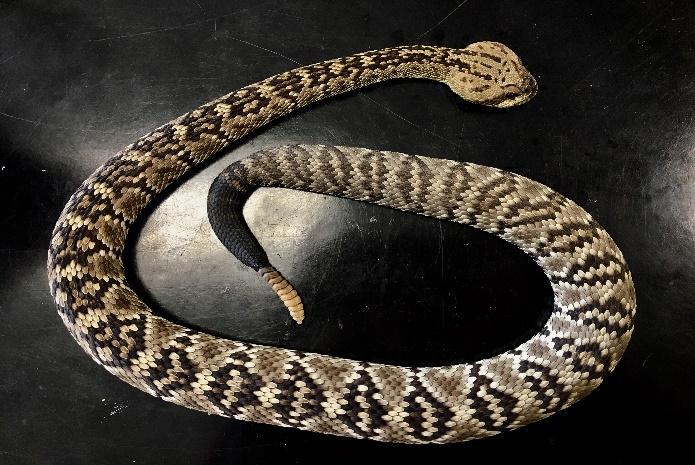
Picture taken by Emily Runnion
The black-tailed rattlesnake is a flashy snake that is almost always found within rocky, mountainous landscapes (Brennan, Holycross, 2009). Similarly to the western diamond-back rattlesnake, they produce large venom yields and potent hemorrhagic toxins that can result in tissue damage (Brennan, Holycross, 2009). The black-tailed rattlesnake is also most active during its mating season (July-September) during the monsoon season (Brennan, Holycross, 2009).
Tiger Rattlesnake (Crotalus tigris)
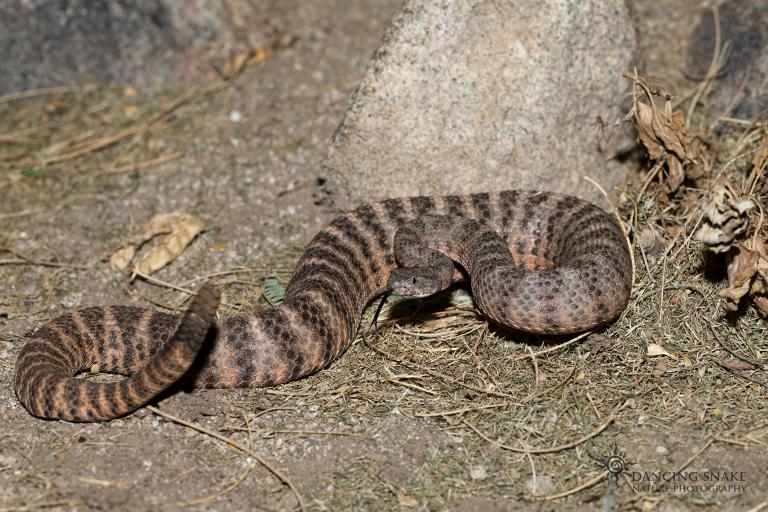
Photo taken by Rene Clark
The tiger rattlesnake is unique among other rattlesnakes because of how small its head is in proportion to its body. The striking tiger-striped markings are a dead give away for the tiger rattlesnake. The venom of the tiger rattlesnake is a neurotoxin making the venom exceptionally toxic (Brennan, Holycross, 2009). The tiger rattlesnake along with others are most active and likely to be seen during the summer monsoons.
Sonoran Coral Snake (Micruroides euryxanthus)
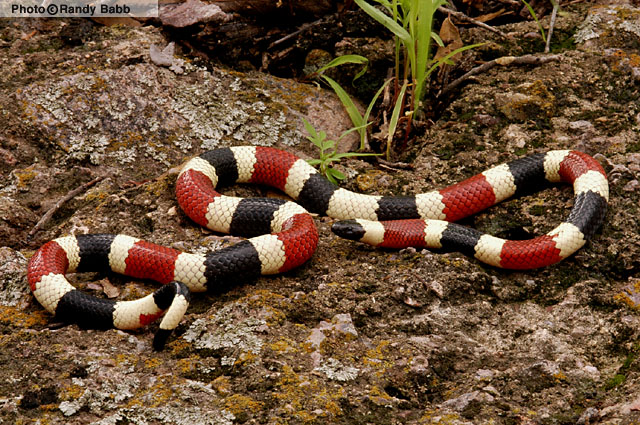
Photo taken by Randy Babb and retrieved from http://www.reptilesofaz.org/Snakes-Subpages/h-m-euryxanthus.html
The Sonoran coralsnake is the only venomous, non-rattlesnake species of snake in Arizona. They are small and generally docile, but should not be handled for potential of being envenomated with neurotoxins.
Non-Venomous Snakes:
Many other non-venomous species of snake can be found at Stone Canyon as well including the following:
Glossy Snake (Arizona Elegans)
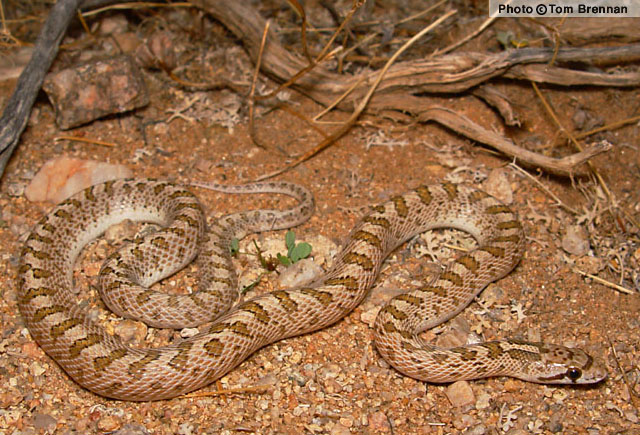
Photo retrieved from http://www.reptilesofaz.org/Snakes-Subpages/h-a-elegans.html
These snakes are commonly confused with the gopher snake, which is also a commonly-sighted resident of Stone Canyon.
Variable Sandsnake (Chilomeniscus stramineus)
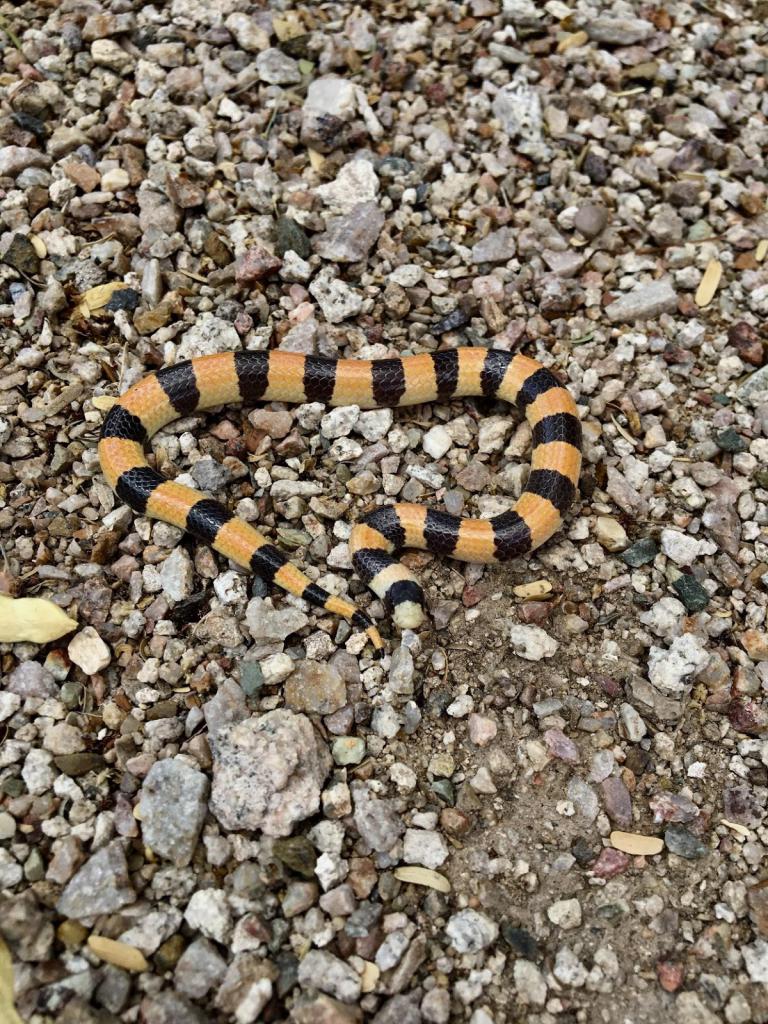
Photo taken by Emily Runnion
These snakes use their snout for maneuvering through sand and burrowing into the ground (Brennan, Holycross, 2009).
Ring Necked Snake (Diadophus punctatus)
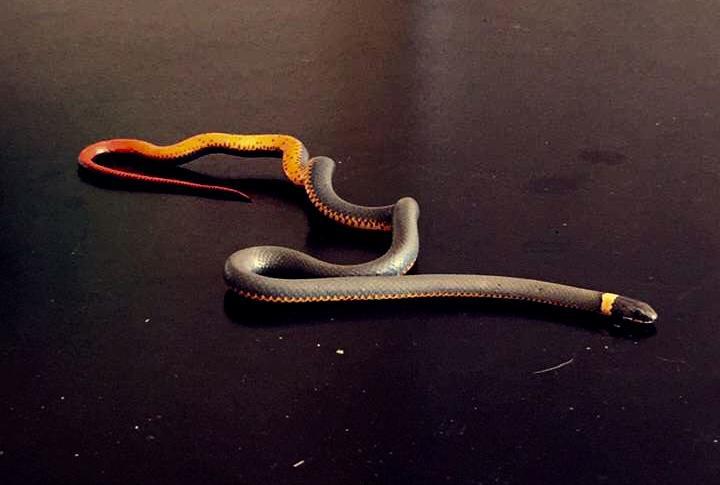
Photo by Josephine Profy
The ring-necked snake is unique in that it has a brightly orange, red, or yellow colored ventral side. The bright colors on the underside of the snake are used as a defense mechanism to ward off predators when the snake is threatened.
Night Snake (Hypsiglena torquata)
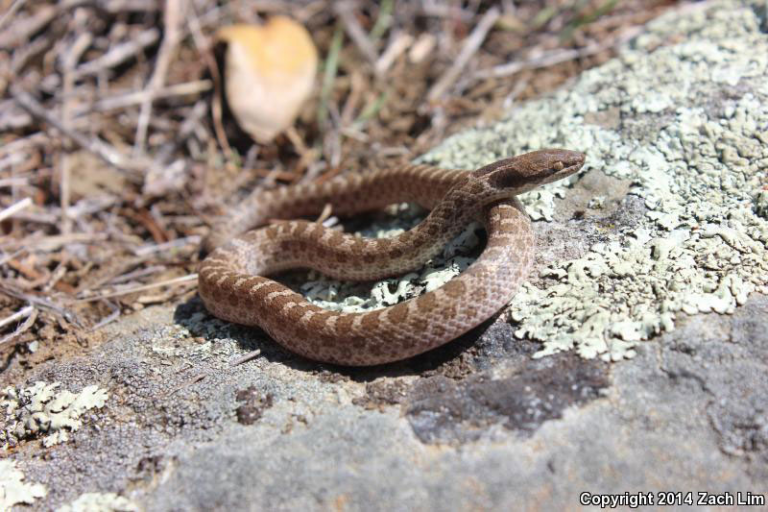
Photo taken by Zach Lim and retrieved from http://www.californiaherps.com/snakes/images/honuchalatasmzl3142.jpg
Night Snakes are found commonly throughout many habitats in Arizona. They can be spotted most easily while road cruising at night.
Common Kingsnake (Lampropeltis getula)

Photo taken by Tom Brennan and retrieved from http://www.reptilesofaz.org/Graphics/Snakes/LAMGET1-09c.jpg
Three color variations of this species occur throughout Arizona. The kingsnake will eat anything from other snakes (rattlesnakes included) to small mammals, birds, and even frogs and toads.
Western Threadsnake (Leptotyphlops humilis)
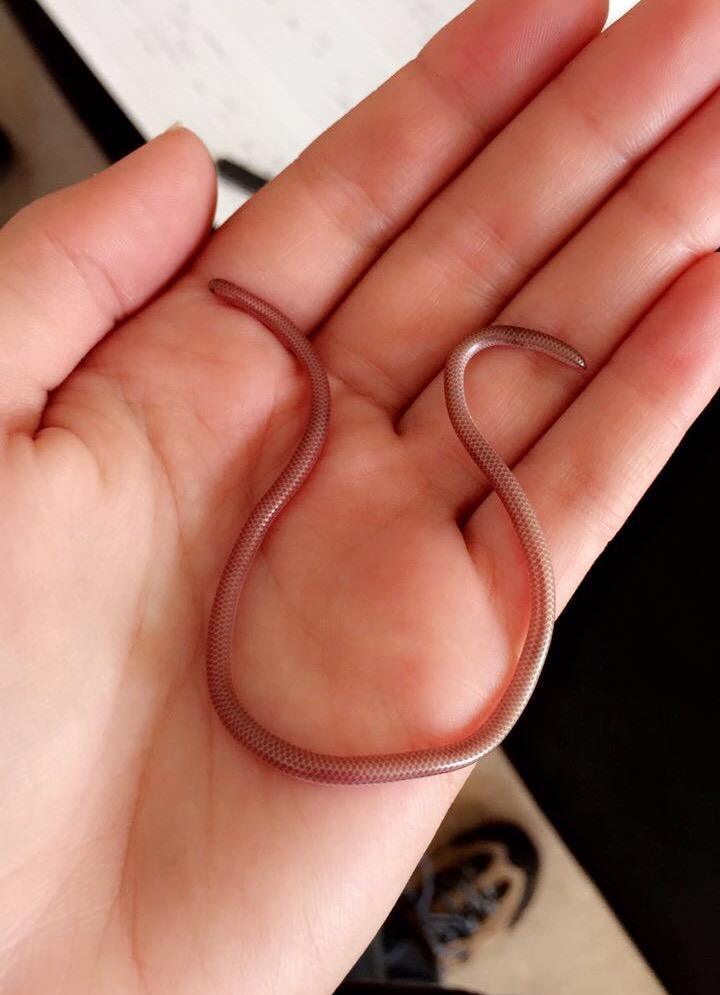
Photo taken by Josephine Profy
These snakes can easily be mistaken for earthworms if you do not look closely enough. They are very common around Tucson and can be seen out and about after it rains.
Sonoran Whipsnake (Masticophis bilineatus)

Photo taken by Todd Pierson and retrieved from http://reptile-database.reptarium.cz/species?genus=Coluber&species=bilineatus&search_param=()
The Sonoran whipsnake is a quick snake that is easily able to climb trees. Their speed on the ground makes them difficult to catch in the field.
Saddled Leaf-nosed Snake (Phyllorhynchus browni)

Photo taken by Tom Brennan and retrieved from http://www.reptilesofaz.org/Snakes-Subpages/h-p-browni.html
The saddle leaf-nosed snake can be distinguished from the spotted leaf-nosed snake because it has fewer than 17 brown saddle markings on the body (Brennan, Holycross, 2009). These snakes selectively feed on lizard and snake eggs (Brennan, Holycross, 2009).
Spotted Leaf-nosed Snake (Phyllorhynchus decurtatus)
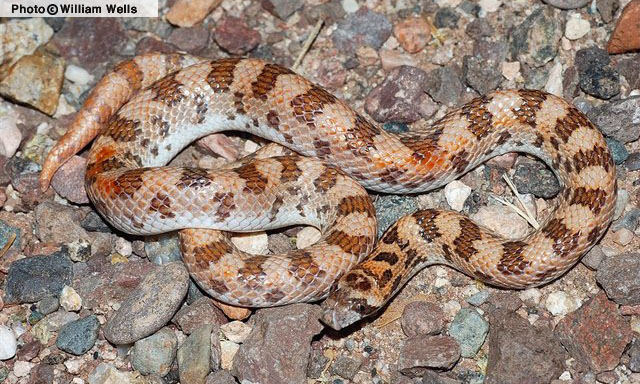
Photo taken by William Wells and retrieved from http://www.reptilesofaz.org/Snakes-Subpages/h-p-decurtatus.html
In contrast to the saddled leaf-nosed snake, these snakes have greater than 17 small brown blotches on the body. Just like the saddle leaf-nosed snake, the spotted leaf-nosed snake specializes in eating lizard and snake eggs.
Gophersnake (Pituophis catenifer)

Photo taken by Tom Brennan and retrieved from http://www.reptilesofaz.org/Snakes-Subpages/h-p-catenifer.html
The Gopher Snake will commonly shake its tail and hiss when it is threatened, which often leads to people mistaking it for a rattlesnake.
Long-nosed snake (Rhinocheilus lecontei)

Photo taken by William Wells and retrieved from http://www.reptilesofaz.org/Snakes-Subpages/h-r-lecontei.html
The Long-nosed Snake has a disgusting defense mechanism of excreting blood and feces from the cloaca when it is threatened. This trait makes them unenjoyable to capture and handle.
Western Patch-nosed Snake (Salvadora hexalepis)
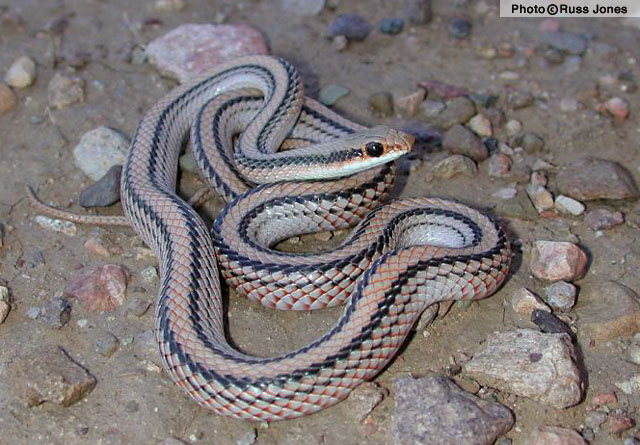
Photo taken by Russ Jones and retrieved from http://www.reptilesofaz.org/Snakes-Subpages/h-s-hexalepis.html
The large “patch” scale on the nose of the snake is most likely used to excavate reptile eggs (Brennan, Holycross, 2009).
Western Ground Snake (Sonora semiannulata)
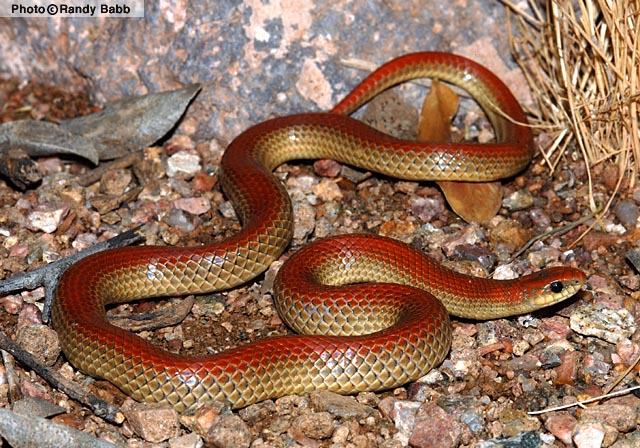
Photo taken by Randy Babb and retrieved from http://www.reptilesofaz.org/Snakes-Subpages/h-s-semiannulata.html
The Western Ground Snake can be seen in a variety of colors including: tan, gray, light orange, or orange and black striped.
Smith’s Black-headed Snake (Tantilla hobartsmithi)

Photo taken by Randy Babb and retrieved from http://www.reptilesofaz.org/Snakes-Subpages/h-t-hobartsmithi.html
The Smith’s black-headed snake spends much of its time underground or under rocks, and little is known about its reproductive traits (Brennan, Holycross, 2009).
Black-necked Garter Snake (Thamnophis cyrtopsis)

Photo taken by Tom Brennan and retrieved from http://www.reptilesofaz.org/Snakes-Subpages/h-t-cyrtopsis.html
Like many Garter Snake species, the Black-necked Garter Snake can commonly be found close to riparian and aquatic areas.
Western Lyresnake (Trimorphodon biscutatus)
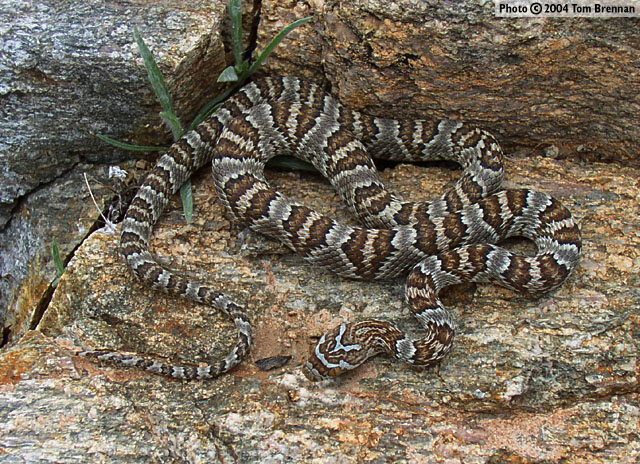
Photo taken by Tom Brennan and retrieved from http://www.reptilesofaz.org/Graphics/Snakes/herp-t-biscutatus-gb-2004.jpg
The Lyresnake acquired its name from the unique lyre-shaped marking on its head. When handled these snakes tend to bite readily, and they do envenomate their prey, although their venom is nothing more than a mild irritant to humans.
Sources
Brennan, Thomas C., and Andrew T. Holycross. A Field Guide to Amphibians and Reptiles in Arizona. Arizona Game and Fish Dept., 2009.
Brennan, Thomas C. “Snakes of Arizona.” Snakes of Arizona, Thomas C. Brennan, 2008, www.reptilesofaz.org/snakes.html.


